Need to temporarily solve the problem of heating your home? Heating elements for heating boilers will do
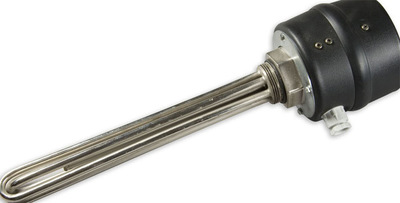
heating element for the heating circuit - this is heating element, which is fixed in the radiator of water heating, boiler and infrared heater.
The device carries out heating of the coolant, which moves along the contour and gives off heat to the environment. Due to this, the room is heated.
Content
- Water heating with heating elements
- Application area: is it suitable for electric boilers and registers?
- Varieties
- How to choose heating elements for batteries and electric boilers
- How to install into the system with your own hands
- How to install a device for use in a garage and a private home
- How to calculate the power of a heating element
- Prevention of breakdowns
- Useful video
- Conclusion
- Comments (1 opinion)
Water heating with heating elements
TEN is a device that is used as primary or auxiliary heating source.
Application area: is it suitable for electric boilers and registers?
The devices are recommended for use in heating buildings. with a small area, which are rarely used in the autumn-winter period. For this purpose, the element is inserted into a radiator of impressive dimensions. Heating elements are mainly used for heating garages, summer houses and other premises.
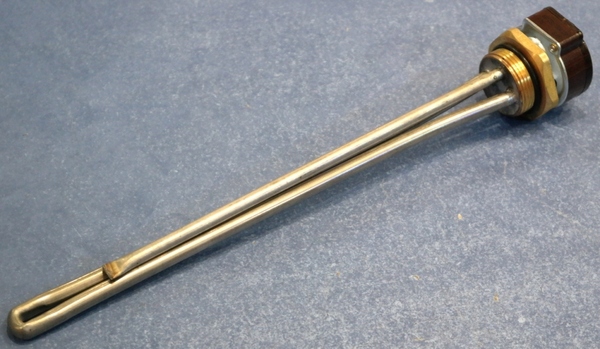
Photo 1. Heating element for a radiator with a regulator, power 1.5 kW, manufacturer - "Tormec", Ukraine.
They are also used for heating private one-story buildings, but very rarely due to high cost of electricity. Here they are often installed not as the main source of heating, but as an auxiliary source of heating in case of a gas outage.
These power elements are connected not only to the gas autonomous system heating, but also to contour, which operates on solid fuel. This is especially important when the inhabitants of the house do not have the opportunity to regularly add coal or firewood to the firebox, as well as monitor the pressure and temperature inside the system.
Important! To save electricity, it is recommended to install dual rate meterThen at night, when the cost of electricity is lower, the system operates from a heating element, and during the day - from solid fuel.
Design
Device design:
- Frame. It is made of electric-welded or solid-drawn tube. Material - stainless steel or carbon steel, coating - chrome or nickel, section - round or flat. The diameter of the tube depends on the model of the device.
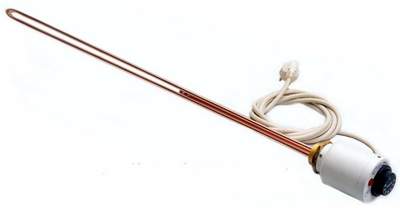
- FillerIt is quartz sand or a mixture of crystalline magnesium oxides.
- Spiral. This is the heating element of the device. It is made of nichrome wire.
- Contact rod in the seal.
- Sealant.
- Insulator.
Advantages and disadvantages
Advantages of the devices:
- ecological cleanliness circuit, since the device does not require any fuel, the combustion of which releases harmful substances into the environment;
- creates autonomous design heating that does not depend on gas or solid fuel;
- compact dimensions;
- large selection of devices different power;
- easy installation;
- safety exploitation;
- there are models with thermostat, thanks to which the heating process is automated.
Disadvantages of elements:
- high cost heat source (electricity);
- device cannot be repaired, if the coil is out of order.
Varieties
There are several types of heating elements:
-
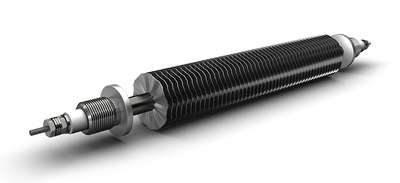
Tubular instruments. This device is the most popular among users. Heat is transferred by convection, conduction or IR radiation.
Copper, stainless steel, ceramics and steel are used as the body material. Length — from 200 to 6000 mm. The diameter of the tube varies. from 5 to 18 mm. The power depends on the model and is 0.3-2.5 kW.
- Finned device. This is a modification of a tubular heating element. This model is distinguished by a large number of thin steel plates, which are located along the entire length of the body. Advantages - high heating speed, due to which the room is quickly heated. The device is recommended for use in air-type heaters.
- Block model. These are several tubular devices that are fixed on the basis of a single mount. The device has high power, so it quickly heats the room. It is used in everyday life and in industrial conditions. The power of the device is 5-10 kW.
- Cartridge device. They are a tube with one free ring. The body material is polished steel. Such models have high power and are used mainly in industrial facilities.
How to choose heating elements for batteries and electric boilers
There are several basic criteria for choosing a device.
Power
When choosing the power of the device, the following factors are taken into account:
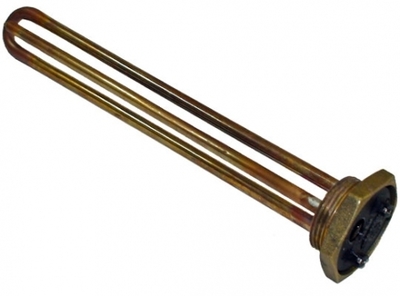
- power heat transfer contours;
- state electrical wiring;
- square heated building.
It is recommended to purchase a device whose power is less than the maximum heat output of the heating system.
Failure to comply with this condition will result in the heating element constantly turning off, which will cause it to break.
In buildings with old wiring, the permissible power of the device is 1.5-2 kW. Using a more powerful device will cause the socket to catch fire. For safe operation of the heating element, it is recommended to replace the wiring with a new one.
Reference! For rooms with a large area, it is recommended to choose more powerful devices, than for small buildings.
Electrical network type
Device up to 3 kW operates from a regular household electrical outlet 220 volts. To use a device with higher power, wiring is performed three-phase network 380 volts.
Technical specifications
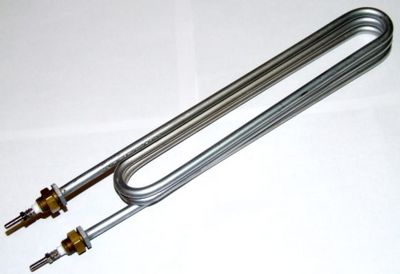
When choosing a heating element, pay attention to the technical characteristics:
- material housings - corrosion-resistant metal or ceramics;
- direction threads plugs - right or left;
- flange diameter - from 0.5 to 1.25 inches;
- length - from 200 to 6000 mm.
Availability of a thermostat
A thermostat is a device for automatic power control Heating element. Its absence leads to increased energy consumption.
How to install into the system with your own hands
Algorithm for installing a heating element in radiators:
- turn off the water supply and drain the coolant from the circuit;
- take out bottom battery plug and replace it with a heating element;
- twist plug;
- install electronics;
- turn on the water.
Features of installation in cast iron and aluminum radiators
When choosing a device, it is important to consider what kind of radiator it is mounted in. Some devices are designed for aluminum batteries, and others for cast iron. It is forbidden to use a heating element for the circuit that is not intended for it.
How to install a device for use in a garage and a private home
Regardless of the type of heating, when installing a heating element to heat a garage or a private home, the following rules are observed:
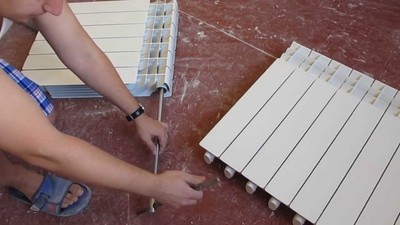
- the premises are equipped high-quality ventilation system;
- can't be kept near flammable substances as a heat source, otherwise a fire will occur;
- installation is in progress fuses, if a large number of electrical appliances are used in the room to prevent overloading of the electrical network and short circuits;
- device do not leave unattended;
- it is not allowed on a radiator that is equipped with a heating element, dry shoes, clothes and any other items.
If the device is installed in the garage heating system, it is recommended to use a filter with a length of no more than 6 meters. If a power surge occurs, it will turn off the device, preventing it from breaking. The cord is kept in such a position that it does not bend or fold.
Attention! You can't put it on the wire heavy equipment, capable of causing mechanical damage.
Heating elements for heating a garage space are not used together with electric convectors, as this creates an increased load on the network.
How to calculate the power of a heating element
To calculate the power of the heating element, use the formula:
P=0.0011*m(Tk-Tn)/T.
Here m — this is the mass of the energy source, Tk- liquid temperature after heating, Tn — the temperature of the coolant before heating, and T — the time it takes to heat the liquid to an acceptable temperature.
Prevention of breakdowns
Preventive measures to prevent device breakdown:
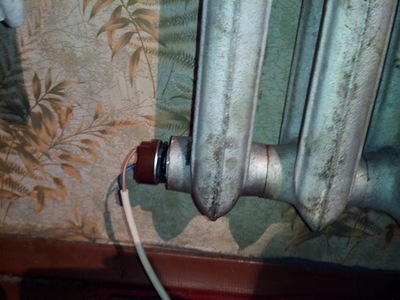
- use as a heat carrier distilled water only, since water from the tap causes scale to form on the body;
- installation Residual current devices, which deactivates the heating element in the event of an emergency;
- execution tightness device for protection against static electricity of the radiator;
- You can't turn it on and off often element, as this reduces its service life;
- It is prohibited to install the device in a heating source or radiator without grounding.
Useful video
Check out the video that shows how to install a heating element in an aluminum radiator.
Conclusion
A heating element is a device that creates heat in a house. safe and efficient heating system. If the operating rules are followed, the device will last for a long time. for several years.









Comments